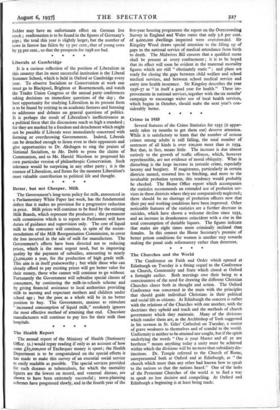Several features of the Crime Statistics for 1935 (it appar-
ently takes 19 months to get them out) deserve attention. While it is satisfactory to learn that the number of serious crimes among adults is still falling, the total number of sentences of all kinds is over roo,000 more than in 1934. But that, in fact, means little. The increase is due almost entirely to the growth of traffic offences, which, however reprehensible, are not evidence of moral obliquity. What is disturbing is the large increase in juvenile crime, especially larceny and burglary. If magistrates, particularly in certain districts named, resorted less to birching, and more to the invaluable probation system, this tendency would probably be checked. The Home Office report which accompanies the statistics recommends an extended use of probation ser- vices in those districts where they are comparatively neglected; there should be no shortage of probation officers now that their pay and working conditions have been improved. Other noticeable features of the statistics are a further decrease in suicides, which have shown a welcome decline since 1932, and an increase in drunkenness coincident with a rise in the total consumption of dutiable liquors. The figures indicate that males are eight times more criminally inclined than females. In this context the Home Secretary's promise of better prison conditions for women is another step towards making the penal code reformatory rather than deterrent.
* * * *






































 Previous page
Previous page